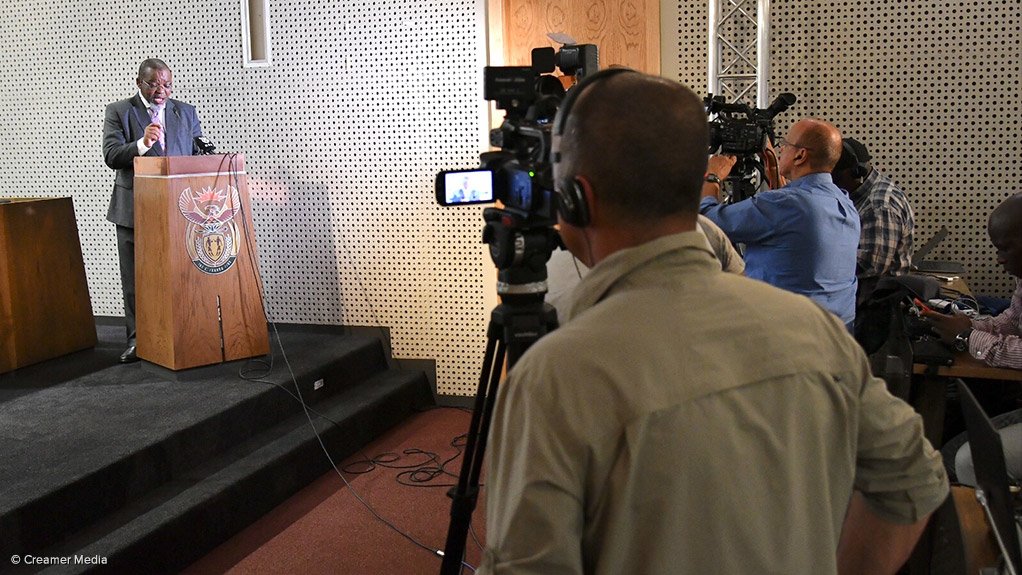Mantashe confirms gazetting of Mining Charter 3
JOHANNESBURG (miningweekly.com) – Mineral Resources Minister Gwede Mantashe on Thursday confirmed that the Mining Charter 3 had officially been gazetted.
Coupled with this, he stated during a media briefing, in Pretoria, that a formal request has been submitted to the Speaker of the National Assembly and the National Council of Provinces chairperson for the withdrawal of the Mineral and Petroleum Resources Development Act (MPRDA) Amendment Bill.
In place of the amendment Bill, a new legal framework will be developed for the sustainable development of the petroleum and gas sectors, respectively.
The Minister did not provide a timeframe for when this would officially be effected, but noted that the new regime for oil and gas would take place once the amendments had been withdrawn.
Thursday’s announcement by the Minister follows seven months of intensive engagements with industry stakeholders, which include mining companies, investors, mining communities, labour, financial institutions, the legal fraternity and Cabinet.
The gazetted charter, Mantashe told the media, represents consensus among stakeholders and is “an important contributory element to efforts aimed at stimulating the economy”.
He elaborated that Mining Charter 3 aims to create regulatory certainty, sustainable growth and a competitive and transformed mining industry, which plays an important role in South Africa, realising its long-term objectives of eliminating poverty, reducing inequality and creating jobs.
Further, the withdrawal of the MPRDA Amendment Bill from Parliament is another step towards creating regulatory and policy certainty and is in line with President Cyril Ramaphosa’s announcement on the decision by Cabinet to withdraw the Bill.
MINING CHARTER ELEMENTS
Mantashe clarified that the elements of ownership and mine community development are ring-fenced and that these require “absolute compliance” at all times.
To entrench regulatory certainty for investors and to provide security of tenure for investments, an existing mining right holder who achieved a minimum of 26% is recognised as compliant for the duration of the right. This, the Minister pointed out, includes a right holder whose black economic empowerment (BEE) shareholder has since exited.
This recognition, however, is not applicable upon renewal, and is not transferrable to a new owner in the case of a transfer or sale.
The 2010 version of the Mining Charter will apply to all pending applications lodged, and accepted, prior to the coming into effect of the Mining Charter in 2018.
Such a right holder, Mantashe noted, will be expected to increase its broad-based BEE shareholding to 30% within five years.
A new mining right, granted after the coming into effect of the new version, must have a minimum of 30% BEE shareholding, which will be applicable for the duration of the mining right.
This 30% BEE shareholding will be distributed through a minimum of 5% nontransferable carried interest to qualifying employees; a minimum of 5% nontransferable carried interest to host communities, or a minimum 5% equity equivalent benefit; as well as a minimum of 20% effective ownership in the form of shares to a BEE entrepreneur, 5% of which must ideally be for women.
For junior miners, the charter outlines requirements.
To promote beneficiation in line with government policy, a mining right holder may claim the equity equivalent mechanism against a maximum of five percentage points of a BEE entrepreneur.
A mining right holder must also submit a beneficiation equity equivalent plan to the Department of Mineral Resources (DMR) for approval.
This, the Minister said, would be outlined in the Mining Charter implementation guidelines.
In terms of inclusive procurement, supplier and enterprise development, the procurement of South African manufactured goods and services provides opportunities for expanding economic growth, creating decent jobs and widening market access to the country’s goods and services, Mantashe stated.
To confirm local content, goods must be procured in line with a standardised product identification coding system, which is currently being developed by the Department of Trade and Industry (DTI).
Mining right holders will be expected to provide proof of local content in the form of certification from the South African Bureau of Standards or any other designated entity.
On promoting research and development (R&D) capabilities, a mining right holder must spend a minimum of 70% of its total R&D budget on South Africa-based entities.
Additionally, in terms of human resource development, which Mantashe said constituted an integral part of competitiveness, transformation and sustainable growth, a mining right holder is expected to invest a minimum of 5% of leviable amount on essential skills development.
This, he elaborated, includes science, technology, engineering and mathematical skills, as well as graduate training programmes and R&D initiatives.
In terms of mine community development, a mining right holder must meaningfully contribute towards mine community development, with a bias towards mine communities both in terms of impact and size, and in keeping with the principles of the social licence to operate.
A trust, or similar vehicle, will oversee the implementation of the 5% equity equivalent detailed under the ownership element, which should have representation from host communities and mining companies.
In terms of housing and living conditions, a mining right holder will also be required to submit a housing and living conditions plan, to be approved by the DMR, after consultation with organised labour and the Department of Human Settlements.
Compliance with the charter, Mantashe averred, requires that mining right holders should submit yearly compliance reports to the DMR.
To adequately monitor and enforce compliance to the charter, he told media that the DMR was continuing with the process of filling key vacant positions to stabilise critical areas, including the monitoring and enforcement of compliance.
Comments
Press Office
Announcements
What's On
Subscribe to improve your user experience...
Option 1 (equivalent of R125 a month):
Receive a weekly copy of Creamer Media's Engineering News & Mining Weekly magazine
(print copy for those in South Africa and e-magazine for those outside of South Africa)
Receive daily email newsletters
Access to full search results
Access archive of magazine back copies
Access to Projects in Progress
Access to ONE Research Report of your choice in PDF format
Option 2 (equivalent of R375 a month):
All benefits from Option 1
PLUS
Access to Creamer Media's Research Channel Africa for ALL Research Reports, in PDF format, on various industrial and mining sectors
including Electricity; Water; Energy Transition; Hydrogen; Roads, Rail and Ports; Coal; Gold; Platinum; Battery Metals; etc.
Already a subscriber?
Forgotten your password?
Receive weekly copy of Creamer Media's Engineering News & Mining Weekly magazine (print copy for those in South Africa and e-magazine for those outside of South Africa)
➕
Recieve daily email newsletters
➕
Access to full search results
➕
Access archive of magazine back copies
➕
Access to Projects in Progress
➕
Access to ONE Research Report of your choice in PDF format
RESEARCH CHANNEL AFRICA
R4500 (equivalent of R375 a month)
SUBSCRIBEAll benefits from Option 1
➕
Access to Creamer Media's Research Channel Africa for ALL Research Reports on various industrial and mining sectors, in PDF format, including on:
Electricity
➕
Water
➕
Energy Transition
➕
Hydrogen
➕
Roads, Rail and Ports
➕
Coal
➕
Gold
➕
Platinum
➕
Battery Metals
➕
etc.
Receive all benefits from Option 1 or Option 2 delivered to numerous people at your company
➕
Multiple User names and Passwords for simultaneous log-ins
➕
Intranet integration access to all in your organisation





















